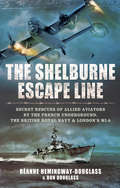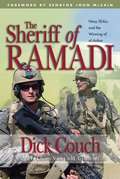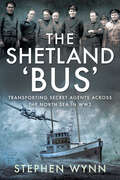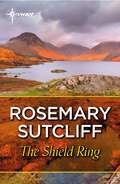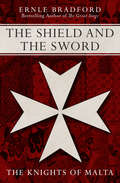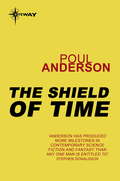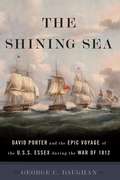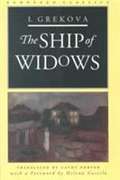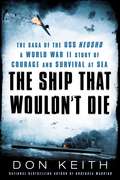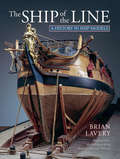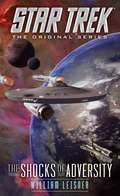- Table View
- List View
The Shattering Peace: Old Man's War Book 7 (Old Man's War)
by John ScalziAfter a decade, acclaimed science fiction master John Scalzi returns to the galaxy of the Old Man's War series with the long awaited seventh book, The Shattering PeaceTHE PEACE IS SHATTERINGFor a decade, peace has reigned in interstellar space. A tripartite agreement between the Colonial Union, the Earth, and the alien Conclave has kept the forces of war at bay, even when some would have preferred to return to the fighting and struggle of former times. For now, more sensible heads have prevailed – and have even championed unity.But now, there is a new force that threatens the hard-maintained peace: The Consu, the most advanced intelligent species humans have ever met, are on the cusp of a species-defining civil war. This war is between Consu factions... but nothing the Consu ever do is just about them. The Colonial Union, the Earth and the Conclave have been unwillingly dragged into the conflict, in the most surprising of ways.Gretchen Trujillo is a mid-level diplomat, working in an unimportant part of the Colonial Union bureaucracy. But when she is called to take part in a secret mission involving representatives from every powerful faction in space, what she finds there has the chance to redefine the destinies of humans and aliens alike... or destroy them forever.At the Publisher's request, this title is being sold without Digital Rights Management Software (DRM) applied.
The Shelburne Escape Line: Secret Rescues of Allied Aviators by the French Underground, the British Royal Navy & London's MI-9
by Don Douglass Réanne Hemingway-DouglassAn account of WWII rescues that &“pays tribute to the audacity and heroism of the men and women of the French Resistance and Allied military personnel&” (Warship World). The Shelburne was one of the later escape lines that operated within Nazi-occupied Europe. It was established at the end of 1943 by two agents who worked for MI-9, the London-based military intelligence agency responsible for providing assistance to Allied servicemen stranded behind enemy lines. Working with the French Resistance, these agents arranged for groups of Allied airmen to be taken from &“safe houses&” in Paris to Brittany, where a Royal Navy motor gunboat picked them up from a secluded beach and delivered them back to England. Eight audacious evacuation operations were conducted between January and August, 1944, without the Shelburne Line ever being infiltrated by the Gestapo. Aspects of the Shelburne story have been told previously in memoirs by several of the participants, including the late MP Airey Neave, who was an MI-9 operative. However, Hemingway-Douglass expands the story to include recollections of some of the local Breton people who were involved with the Line. The second half of the book comprises personal stories of airmen and other individuals who were affiliated with the Shelburne Line or were otherwise caught up in the war in France. A lifelong Francophile, Hemingway-Douglass took eight years to research and write the book. She describes it as a labor of love that pays tribute to the heroism and courage of &“ordinary&” people, while reinforcing the fact that war touches everybody.&“Fascinating . . . A must read for military and espionage enthusiasts.&” —The Bulletin (Military Historical Society)
The Shenandoah Valley Campaign of 1862
by Gary W. GallagherThis volume explores the Shenandoah Valley campaign, best known for its role in establishing Thomas J. "Stonewall" Jackson's reputation as the Confederacy's greatest military idol. The authors address questions of military leadership, strategy and tactics, the campaign's political and social impact, and the ways in which participants' memories of events differed from what is revealed in the historical sources. In the process, they offer valuable insights into one of the Confederacy's most famous generals, those who fought with him and against him, the campaign's larger importance in the context of the war, and the complex relationship between history and memory. The contributors are Jonathan M. Berkey, Keith S. Bohannon, Peter S. Carmichael, Gary W. Gallagher, A. Cash Koeniger, R. E. L. Krick, Robert K. Krick, and William J. Miller.
The Shenandoah Valley Campaign of 1864
by Gary W. GallagherGenerally regarded as the most important of the Civil War campaigns conducted in the Shenandoah Valley of Virginia, that of 1864 lasted more than four months and claimed more than 25,000 casualties. The armies of Philip H. Sheridan and Jubal A. Early contended for immense stakes. Beyond the agricultural bounty and the boost in morale a victory would bring, events in the Valley also would affect Abraham Lincoln's chances for reelection in the November 1864 presidential canvass. The eleven original essays in this volume reexamine common assumptions about the campaign, its major figures, and its significance. Taking advantage of the most recent scholarship and a wide range of primary sources, contributors examine strategy and tactics, the performances of key commanders on each side, the campaign's political repercussions, and the experiences of civilians caught in the path of the armies. The authors do not always agree with one another, yet, taken together, their essays highlight important connections between the home front and the battlefield, as well as ways in which military affairs, civilian experiences, and politics played off one another during the campaign.Contributors:William W. Bergen, Charlottesville, VirginiaKeith S. Bohannon, State University of West GeorgiaAndre M. Fleche, University of VirginiaGary W. Gallagher, University of VirginiaJoseph T. Glatthaar, University of North Carolina at Chapel HillRobert E. L. Krick, Richmond, VirginiaRobert K. Krick, Fredericksburg, VirginiaWilliam J. Miller, Churchville, VirginiaAaron Sheehan-Dean, University of North FloridaWilliam G. Thomas, University of Nebraska-LincolnJoan Waugh, University of California, Los AngelesGenerally regarded as the most important Civil War military operation conducted in the Shenandoah Valley of Virginia, the campaign of 1864 lasted more than four months and claimed more than 25,000 casualties. Beyond the loss of agricultural bounty to the Confederacy and the boost in Union morale a victory would bring, events in the Valley also would affect Abraham Lincoln's chances for reelection in the November 1864 presidential canvass. The eleven original essays in this volume reexamine common assumptions about the campaign, its major figures, and its significance. Taking advantage of the most recent scholarship and a wide range of primary sources, contributors consider strategy and tactics, the performances of key commanders on each side, the campaign's political repercussions, and the experiences of civilians caught in the path of the armies. The contributors are William W. Bergen, Keith S. Bohannon, Andre M. Fleche, Gary W. Gallagher, Joseph T. Glatthaar, Robert E. L. Krick, Robert K. Krick, William J. Miller, Aaron Sheehan-Dean, William G. Thomas, and Joan Waugh. The editor is Gary W. Gallagher.-->
The Shenandoah Valley Campaigns, Omnibus E-book
by Gary W. GallagherThis Omnibus ebook contains the two-volume collection of essays, edited by Gary Gallagher, that covers the Shenandoah Valley Campaigns of 1862 and 1864.1862:This volume explores the Shenandoah Valley campaign, best known for its role in establishing Thomas J. "Stonewall" Jackson's reputation as the Confederacy's greatest military idol. The authors address questions of military leadership, strategy and tactics, the campaign's political and social impact, and the ways in which participants' memories of events differed from what is revealed in the historical sources. In the process, they offer valuable insights into one of the Confederacy's most famous generals, those who fought with him and against him, the campaign's larger importance in the context of the war, and the complex relationship between history and memory.The contributors are Jonathan M. Berkey, Keith S. Bohannon, Peter S. Carmichael, Gary W. Gallagher, A. Cash Koeniger, R. E. L. Krick, Robert K. Krick, and William J. Miller.1864:Generally regarded as the most important Civil War military operation conducted in the Shenandoah Valley of Virginia, the campaign of 1864 lasted more than four months and claimed more than 25,000 casualties. Beyond the loss of agricultural bounty to the Confederacy and the boost in Union morale a victory would bring, events in the Valley also would affect Abraham Lincoln's chances for reelection in the November 1864 presidential canvass. The eleven original essays in this volume reexamine common assumptions about the campaign, its major figures, and its significance. Taking advantage of the most recent scholarship and a wide range of primary sources, contributors consider strategy and tactics, the performances of key commanders on each side, the campaign's political repercussions, and the experiences of civilians caught in the path of the armies. The contributors are William W. Bergen, Keith S. Bohannon, Andre M. Fleche, Gary W. Gallagher, Joseph T. Glatthaar, Robert E. L. Krick, Robert K. Krick, William J. Miller, Aaron Sheehan-Dean, William G. Thomas, and Joan Waugh. The editor is Gary W. Gallagher.
The Shepherd
by Frederick ForsythChristmas Eve, 1957: An RAF pilot needs a miracle to make it home as his fighter jet begins to fail, in a story by the #1 New York Times–bestselling author. It is Christmas Eve, 1957, and there are cozier places to be than the cockpit of a de Havilland Vampire fighter plane. But for the Royal Air Force pilot who has just taken off from West Germany, this single-seat jet is the only way to make it back to England for Christmas morning. His flight plan is simple; the fuel tank is full. In sixty-six minutes, he will be back in Blighty. But then the plane begins to fail. First the compass goes haywire, then the radio dies. Lost and alone above the English coast, the pilot is searching for a landing strip when the fog closes in, signaling certain death. He has given up hope when a second shadow appears—a Mosquito fighter-bomber of World War II vintage. The plane is a &“shepherd,&” guiding the Vampire to a safe landing, and its appearance is a gift from fate, a miracle out of time—but for one lonely pilot, the mystery has just begun. A classic bestseller, beloved by aviation fans (including actor John Travolta, who calls it &“one of my favorites because it personalizes the two planes&”) and general readers alike, The Shepherd is a gripping, heartwarming tale for a cold winter&’s night.
The Sheriff of Ramadi
by Dick CouchIn this ground-breaking book, best-selling author and former U.S. Navy SEAL Dick Couch reports on the actions of the SEAL Task Unit during the Battle of Ramadi in Iraq s al-Anbar Province between 2005 and 2007. When he began his research, the author thought he would be writing about the SEALs courage in the face of a losing cause. Instead, he discovered a startling success story whose importance has gone unrecognized in the war against al-Qaeda. Couch argues that the lessons of Ramadi, with SEALs fighting alongside regular forces in an urban war zone, call for using this strategy more widely. One of the most significant military engagements in the global war against terrorism since 9/11 and the most sustained and vicious engagement ever fought by SEALs, the Battle of Ramadi demonstrates both their code of brotherhood and ability to adapt in an urban battle space, which Couch identifies as the keys to the SEALs success on the battlefield. The story of PO2 Michael Monsoor, who was posthumously awarded the Medal of Honor for his bravery during the battle, is a compelling example of their extraordinary brotherhood. First published in hardcover in 2008, the book is now available in paperback for the first time.
The Sherrin: A bloody battle on and off the field
by Peter StanleyThe island of New Aachen is a hotbed of turmoil, with more than just the enemy in the firing line.In May 1945, as Europe celebrates the end of WWII, the Pacific theatre remains a brutal battleground. On the remote Pacific Island of New Aachen, the site of a massacre of Australian troops three years prior, tensions run high. David Wachter, a veteran turned war historian clerk, joins a group of correspondents to cover the conflict and bring home the story of these battle-worn Australian troops. In a tense week, Wachter and his group will confront how they can—and can&’t—depict the truth of war. As tensions between conscripted Militia and volunteer AIF soldiers simmer, the cynical Lieutenant Connellan, a survivor of the massacre, struggles to keep the correspondents in line—a task growing more complicated by the minute. Despite his desire to remain an observer, Wachter is drawn into the chaos. The rivalry between the men threatens to bring a crisis to the front line. The Militia, authorised to operate up to the Equator, face a crucial turning point as New Aachen sits on that very line. The Brigadier&’s desperate attempt to boost morale with an Australian Rules football match, played with the island's only ball, the legendary 'Sherrin', could either unite the troops or incite further unrest. As the Japanese approach, the battalion launches an attack on a steep, sugar-loaf knoll nicknamed the Sherrin, just across the Equator. What will happen when disaffected militiamen reach that imaginary line? And what happens when Connellan confronts the island&’s harrowing past?
The Shetland 'Bus': Transporting Secret Agents Across the North Sea in WW2
by Stephen WynnA history of the World War II clandestine special operations group that linked German-occupied Norway with Scotland&’s Shetland Islands. The Shetland Bus was not a bus, but the nickname of a special operations group that set up a route across the North Sea between Norway and the Shetland Islands, north-east of mainland Scotland. The first voyage was made by Norwegian sailors to help their compatriots in occupied Norway, but soon the Secret Intelligence Service and the Special Operations Executive asked if they would be prepared to carry cargoes of British agents and equipment, as well. Fourteen boats of different sizes were originally used, and Flemington House in Shetland was commandeered as the operation&’s HQ. The first official journey was carried out by the Norwegian fishing vessel the Aksel, which left Luna Ness on 30 August 1941 on route to Bremen in Norway. This book examines that first journey, as well later ones, and discusses the agents and operations which members of the Shetland Bus were involved in throughout the war. It also looks at the donation of three submarine chasers to the operation, made in October 1943, by the United States Navy. These torpedo-type boats were 110 ft long and very fast, allowing journey times between Shetland and Norway to be greatly reduced and carried out in greater safety. The story of the Shetland Bus would be nothing without the individuals involved, both the sailors of the boats and the agents who were carried between the two countries. These were very brave individuals who helped maintain an important lifeline to the beleaguered Norwegians. It also allowed British and Norwegian agents a way into Norway so that they could liaise with the Norwegian Underground movement and carry out important missions against the German occupiers.Praise for The Shetland &‘Bus&’ &“Wynn—who has written or co-written several books on the Second World War—is to be commended for his detailed account of a captivating and understudied moment in the history of special operations. . . . Wynn&’s readable and engaging account of his subject explores the intersections of transnational, Second World War, and special operations history. As a result, it should be of interest to a wide readership.&” —The Northern Mariner &“Very highly recommended.&” —Firetrench &“A great book about individual spies and sailors from both sides of the water putting their lives at great risk. I really enjoyed this book and it was written in a bit of diary style, plenty of information and photographs. I certainly recommend this book to all.&” —UK Historian
The Shield Ring
by Rosemary SutcliffBjorn and Frytha share a bond, both orphans and survivors of Norman attacks on their homes in the Lake country. Growing up together in Jarl Buthar's Norse stronghold, they become fast friends, with Bjorn dreaming of becoming a harper like his father.As they come of age within this secret fortress, they hear word of the Norman attacks beyond their walls, drawing ever closer to the safety of their home. Can they help protect their adoptive home and family, or will they lose everything all over again?
The Shield Ring
by Rosemary SutcliffBjorn and Frytha share a bond, both orphans and survivors of Norman attacks on their homes in the Lake country. Growing up together in Jarl Buthar's Norse stronghold, they become fast friends, with Bjorn dreaming of becoming a harper like his father.As they come of age within this secret fortress, they hear word of the Norman attacks beyond their walls, drawing ever closer to the safety of their home. Can they help protect their adoptive home and family, or will they lose everything all over again?
The Shield and the Sword: The Knights Of St John Jerusalem Rhodes And Malta
by Ernle BradfordAn authoritative history of the Knights of St. John, from Jerusalem to Malta, told by the bestselling author of The Great Siege. Known by many names through their centuries-long career, The Knights Hospitaller of Saint John dedicated themselves to defending the poor and sick. First formed in Jerusalem during the Crusades of the eleventh century, the Order of Saint John grew in wealth and power rivaled only by the Knights Templar. They survived exile from the Holy Land, settling first in Rhodes and then in Malta, which they famously defended against the Ottoman Empire&’s epic invasion of 1565. Even after losing Malta to Napoleon Bonaparte two centuries later, the Order of Saint John continued its mission. Ernle Bradford, whose bestselling book The Great Siege recounts their historic battle for Malta, follows the Knights of Saint John through centuries of war, politics, rivalry, and perseverance in The Shield and the Sword.
The Shield of Achilles: War, Peace, and the Course of History
by Philip BobbittHistory of war and international relations with commentary and theses.
The Shield of Time: A Time Patrol Book (TIME PATROL)
by Poul AndersonMase Everard is a man with a mission. As an Unattached Agent of the Time Patrol, he's to go anyplace - and anytime! - where humanity's transcendent future is threatened by the alteration of the past. This is Manse's profession, and his burden: for how much suffering, throughout human history, can he bear to "preserve"?Wanda Tamberley is a Patrol member in search of her mission. Recruited from sunny California in the late 20th century, she'd rather serve as a scientist in the research branch, exploring Earth's flora and fauna in epochs long past. But as hints accumulate from the Patrol's mysterious leaders uptime, it's beginning to look as if a lot of human history depends on her personal decisions - and Manse's.Meanwhile, the Exaltationists are on the loose, determined to revise human history and rule Time forever and Manse Everard is sworn to stop them, no matter what the heartbreaking cost!
The Shifter's Choice
by Jenna KernanThey took his humanity...but left a hero's heart. Feisty and street-wise, Private Sofia Touma has too much at stake to risk being distracted from her duty to the marine corps. That is, until she's assigned to help the compelling and disabled veteran Johnny Lam. More than a war hero, he's also a werewolf who can't shift back to human form. And Sofia is quickly, inexplicably drawn to him. Unlike Sofia, Johnny understands the risks involved in her loving a monster. But with each day bringing them closer together, he isn't sure he'll be able to continue to do the honorable thing...or protect her from the enemies intent on keeping him a werewolf forever.
The Shining Sea: David Porter and the Epic Voyage of the U.S.S. Essex during the War of 1812
by George C. DaughanShortly after the outbreak of the War of 1812, Captain David Porter set out at the helm of the USS Essex, intent on rounding Cape Horn and hunting British whaling and merchant ships in the Pacific Ocean. Porter’s odyssey took him to exotic isles and brought glory to the fledgling American navy, and in The Shining Sea, celebrated historian George C. Daughan tells the full story of this historic voyage for the first time. Porter’s cruise is now regarded as the greatest maritime adventure of the period, but his monomaniacal quest to capture a British man-of-war ultimately cost him his ship and the lives of over two-thirds of his crew--a disgraceful end to a daring journey. A thrilling narrative of risk and ruin on the high seas, The Shining Sea brings to life one of the war’s greatest tragedies, capturing Porter’s immense hubris and his cataclysmic failure.
The Ship Of Widows (European Classics)
by Cathy Porter Helena Goscilo I. Grekova"My husband was killed at the front right at the beginning of the war." Thus opens The Ship of Widows, the story of five women brought together in a large communal apartment by the vagaries of war in the year 1943. The narrative traces the ebb and flow of their relationships and the changes wrought in their lives by the birth of a son to one of the women. Grekova conveys vividly not only the decisive differences between the postwar generation and those who participated in the defense of their country, but also the extraordinary capacity of human nature to endure and overcome seemingly unendurable suffering and deprivation. Above all, this text spotlights female experiences of the war: the fate of those who did not engage in battle at the front, but fought just as desperately to survive starvation, cold, and exhaustion, to maintain homes and, in a sense, a country to which soldiers could return. Ship of Widows provides a cultural key to an understudied period of Russia's history and an understudied segment of its population - women. This new paperback edition includes an illuminating foreword by Helena Goscilo.
The Ship That Wouldn't Die
by Don KeithAn acclaimed naval historian tells one of the most inspiring sea stories of World War II: the Japanese attack on the American oiler USS Neosho and the gutsy crew's struggle for survival as their slowly sinking ship drifted--lost, defenseless, and alone--on the treacherous Coral Sea.In May 1942, Admiral Jack Fletcher's Task Force 17 closed in for the war's first major clash with the Japanese Navy. The Neosho, a vitally important tanker capable of holding more than 140,000 barrels of fuel, was ordered away from the impending battle. Minimally armed, she was escorted by a destroyer, the Sims. As the Battle of the Coral Sea raged two hundred miles away, the ships were attacked by Japanese dive bombers. Both crews fought valiantly, but when the smoke cleared, the Sims had slipped beneath the waves, and the Neosho was ablaze and listing badly, severely damaged from seven direct hits and a suicide crash. Scores of sailors were killed or wounded, while hundreds bobbed in shark-infested waters. Fires on board threatened to spark a fatal explosion, and each passing hour brought the ship closer to sinking. It was the beginning of a hellish four-day ordeal as the crew struggled to stay alive and keep their ship afloat, while almost two hundred men in life rafts drifted away without water, food, or shelter. Only four of them would survive to be rescued after nine days.Working from eyewitness accounts and declassified documents, Keith offers up vivid portraits of Navy heroes: the Neosho's skipper, Captain John Phillips, whose cool, determined leadership earned him a Silver Star; Lieutenant Commander Wilford Hyman, skipper of the Sims, who remained on his vessel's bridge throughout the attack and made the ultimate sacrifice to try to save his ship; Seaman Jack Rolston, who pulled oil-soaked survivors out of the water and endured days adrift in an open life raft; and Chief Watertender Oscar Peterson, whose selflessness saved the lives of innumerable shipmates and earned him a posthumous Medal of Honor.A tale of a ship as tough and resilient as its crew, The Ship That Wouldn't Die captures the indomitable spirit of the American sailor--and finally brings to the surface one of the great untold sagas of the Pacific War.
The Ship of the Line: A History in Ship Models (A\history In Ship Models Ser.)
by Brian Lavery&“A beautiful book . . . a goldmine of information to anyone interested in the capital ships of the sailing navy of the 17th and 19th Centuries.&”—Ships in Scale The National Maritime Museum in Greenwich houses the largest collection of scale ship models in the world, many of which are official, contemporary artifacts made by the craftsmen of the navy or the shipbuilders themselves, and ranging from the mid-seventeenth century to the present day. As such they represent a three-dimensional archive of unique importance and authority. Treated as historical evidence, they offer more detail than even the best plans, and demonstrate exactly what the ships looked like in a way that even the finest marine painter could not achieve. The Ship of the Line is the second of a new series that takes selections of the best models to tell the story of specific ship types—in this case, the evolution of the ship of the line, the capital ship of its day, and the epitome of British seapower during its heyday from 1650-1850. This period also coincided with the golden age of ship modelling. Each volume depicts a wide range of models, all shown in full color, including many close-up and detail views. These are captioned in depth, but many are also annotated to focus attention on interesting or unusual features, and the book weaves the pictures into an authoritative text, producing a unique form of technical history. The series is of particular interest to ship modellers, but all those with an enthusiasm for the ship design and development in the sailing era will attracted to the in-depth analysis of these beautifully presented books.
The Ship that Held the Line
by Lislie RoseThe American fleet aircraft carrier Hornet is widely acknowledged for the contributions she made to the war effort. The Doolittle Raid, launched from the Hornet's deck, inaugurated America's Pacific counteroffensive and transformed the aircraft carrier into one of the world's prime strategic weapon systems. She was one of three carriers to participate in the victory at Midway and the fighting around Guadalcanal. Through the experiences of this key warship and the eyes of her crew and the aviators who flew from her deck, Lisle Rose recreates the first desperate year of the war in the Pacific. He tells how the Hornet was molded into a deadly weapon of war, how the ship was fought and ultimately lost, and what it was like to live aboard her at a time when the fate of the United States depended on the Navy's tiny carrier fleet.In chronicling the carrier's operational history, the author contends that the fate of the Hornet's air group at Midway remains one of the great controversies in modern naval history and that the ship's importance in helping to keep the Japanese juggernaut at bay during the most critical period of the Pacific war is incontestable. His arguments ring true today as the controversy continues. Rose succeeds both in letting the reader see things the way the men of the Hornet did and in placing their experiences in a broad historical context.
The Shipyard Girls on the Home Front (The Shipyard Girls Series #10)
by Nancy RevellTHE TENTH NOVEL IN THE BESTSELLING SHIPYARD GIRLS SERIES'Emotional and gripping' Take a BreakDecember 1943 As the war effort gathers steam in Europe, it's all hands on deck on the home front. Gloria is over the moon to be reunited with her sweetheart Jack. But her sons Bobby and Gordon are away with the Navy and still know nothing of their mother's divorce and new half-sister. Rosie's squad of welders must work gruelling hours in the yard as they prepare for the Allied invasion of Normandy. All the while Rosie herself waits anxiously for news of her husband Peter, who is carrying out dangerous work as an undercover operative in France. Meanwhile welder Dorothy has a feeling that her beau Toby is planning to pop the question when he's next on leave. But it seems that her head is being turned by someone closer to home... It will take great strength and friendship if the shipyard girls are to weather the storms to come.______________________________Praise for Nancy Revell 'Nancy Revell knows how to stir the passions and soothe the heart!' Northern Echo 'Stirring and heartfelt storytelling' Peterborough Evening Telegraph
The Shock of War: Civilian Experiences, 1937-1945 (International Themes And Issues Ser. #2)
by Sean KennedyIn The Shock of War: Civilian Experiences, 1937-1945, Sean Kennedy shifts the reader's focus from the battlefields of the Second World War to the civilian experience. This short yet comprehensive history complements existing studies of the war that document diplomatic and military operations. While many of these studies acknowledge the significance of the conflict for civilians, The Shock of War places civilians at the centre of events, drawing attention to the many different regions of the world affected by the conflict, and comparing various facets of the civilian experience. Kennedy's fresh approach emphasizes the diverse and complex impact of the war, which was profoundly destructive, yet, in some societies, provided opportunities and the potential for positive change.
The Shocks of Adversity: The Shocks of Adversity (Star Trek: The Original Series)
by William LeisnerAn original novel set in the universe of Star Trek: The Original Series!Located far beyond the boundaries of explored space, the Goeg Domain is a political union of dozens of planets and races. When the U.S.S. Enterprise arrives in its territory to investigate an interstellar phenomenon, Commander Laspas of the Domain Defense Corps is at first guarded, then fascinated to discover the existence of an alliance of worlds much like his own, and finds a kindred spirit in Captain James T. Kirk. And when the Enterprise is attacked by the Domain’s enemies, crippling the starship’s warp capability and leaving its crew facing the prospect of a slow, months-long journey home, the Goeg leader volunteers the help of his own ship, offering to combine the resources of both vessels to bring the Enterprise to a nearby Domain facility to make the necessary repairs. But what at first seems to be an act of peace and friendship soon turns out to be a devil’s bargain, as Kirk and the Enterprise crew learn that there are perhaps more differences than similarities between the Federation and the Domain. When the Goeg’s adversaries strike again, the Enterprise is drawn deeper and inexorably into the conflict, and Kirk begins to realize that they may have allied themselves with the wrong side....
The Shoemaker and his Daughter
by Conor O'CleryWINNER OF THE 2020 MICHEL DÉON PRIZE'O'Clery takes us into the hidden heart of Soviet Russia... An arresting and evocative story' Keggie Carew, author of Dadland'A tour de force ... Love, politics, murder, wars, and the fracturing of ties, personal and ethnic. O'Clery is a gifted writer' Luke Harding, bestselling author of CollusionThe Soviet Union, 1962. Gifted shoemaker Stanislav Suvorov is imprisoned for five years. His crime? Selling his car for a profit. On his release, social shame drives him and his family into voluntary exile in Siberia, 5,000 kilometres from home. In a climate that's unfriendly both geographically and politically, it's their chance to start again. The Shoemaker and His Daughter is an epic story spanning the Second World War to the fall of the Soviet Union, taking in eighty years of Soviet and Russian history, from Stalin to Putin. Following the footsteps of a remarkable family Conor O'Clery knows well - he is married to the shoemaker's daughter - it's both a compelling insight into life in a secretive world at a siesmic moment in time and a powerful tale of ordinary lives shaped by extraordinary times.
The Shogun's Scroll
by Stephen F. KaufmanIn the tradition of The Art of War and The Book of Five Rings, Stephen Kaufman's The Shogun's Scroll offer timeless advice on success in war and life. Written in the voice of Hidetomo Nakadai, a late twelfth century scholar and servant in the court of Minamoto Yoritomo-the first shogun of Japan and one of the world's most ruthless generals-this treatise can be used as a guide for personal development and motivation.

